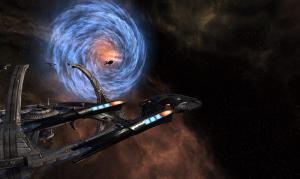Blog
Was Science Fiction
Right About Wormholes?
1 February 2019
 brownpau
brownpauWhen it comes to interstellar travel, the biggest challenge is simply getting there. Our universe is so vast that a simple journey to the stars can take decades or centuries even at the speed of light. So science fiction often comes up with some way to shorten the journey. Hyperspace, warp drive, and such, simply to avoid the boring journey between stars. Most of these ideas simply “make it so” without worrying about the scientific details, but for those who like their science fiction a bit harder, the most popular idea is the wormhole.
The idea of a wormhole first proposed by none other than Einstein himself. In 1935 he wrote a paper with Nathan Rosen about how his theory of gravity might allow you to connect two distant points in space. Their idea wasn’t trying to solve the challenges of space travel, but rather trying to connect gravity to particle physics. It’s a problem that vexes us to this day. But it was noted that this “Einstein-Rosen bridge” looks rather familiar. From the outside one end looks like a black hole, where things enter and don’t return. The other end looks like the opposite. A kind of white hole where things seem to appear from nowhere. This led to the idea that perhaps black holes could be wormholes to distant galaxies, or even other universes.
But when you start looking at the details, that idea doesn’t really seem to work. While Einstein and Rosen were right that in theory you could make a wormhole, it turns out they aren’t stable. In principle space and time can be warped and bent in lots of interesting ways, but it wouldn’t stay that way. Make a wormhole between distant stars, and the tunnel will collapse and pinch off before you have a chance to traverse it. Some folks suggested lining the wormhole with some kind of strong matter to keep it open, but it turns out that the mass of that matter would just cause the wormhole to collapse even more quickly. In the 1970s Kip Thorne and others showed you could line a wormhole with “exotic matter” to keep it open, but that exotic matter couldn’t be any kind of matter that existed. Basically, you could make a transversable wormhole if you also had magic pixie dust. So much for that idea.
But hard science fiction writers are nothing if not persistent. The original wormhole ideas looked at the simplest type of black holes known as the Schwarzchild metric. These are black holes that are in a vacuum and don’t rotate. Real black holes rotate. If Schwarzchild black holes can’t be wormholes, perhaps rotating ones can. In 1963 Roy Kerr found a solution to general relativity for a rotating black hole. This Kerr metric, as it came to be known, has some interesting properties. For one it twists space around it, a property known as frame dragging. Any spaceship near a rotating black hole could use frame dragging to get a big burst of speed. For another, Kerr black holes have a different kind of interior than a Schwarzchild black hole. If a black hole isn’t rotating, all of its matter is forced to compress into a single infinitesimal point known as a singularity. Anything that enters the black hole can’t avoid falling into that singularity, so if your spaceship goes into the black hole it will be crushed. A rotating black hole also contains a singularity, but because of its rotation it forms as a ring rathter than a point. And things aren’t forced to collapse into the ring singularity. It’s possible for your spaceship to enter a rotating black hole and avoid being crushed by the singularity. Of course, according to standard physics you’d still be trapped forever by the black hole.
Maybe there is a way to make a kind of Twisted Einstein-Rosen Bridge. Connect two rotating black holes to make a wormhole that doesn’t collapse on itself without the need for pixie dust. Unfortunately the mathematics for rotating black holes is really complex. Most of the work on rotating black holes uses computer simulations. These are perfectly fine if you want to study the dynamics of real black holes, but to prove wormholes possible you need an exact solution. So far no one has found an exact wormhole solution for rotating black holes in our universe.
To simplify things, a team looked at a wormhole model in what is known as AdS2. This is a simple two-dimensional space that is nothing like our real universe, but has some similar mathematical properties. They found that black holes in this space can be connected to form traversable wormholes.1 Not only do these wormholes stay open, they also don’t collapse when energy passes through it. So at least in AdS2 wormholes are possible.
It should be emphasized that this doesn’t mean wormholes can exist in our universe. While there are some nice similarities between the space of our universe and AdS2, there are also important differences. Those differences might still prevent wormholes from happening. But the theoretical door is open, so perhaps science fiction was right about wormholes after all.
Dongsu Bak, et al. Transparentizing Black Holes to Eternal Traversable Wormholes, arXiv preprint arXiv:1901.07679 (2019). ↩︎